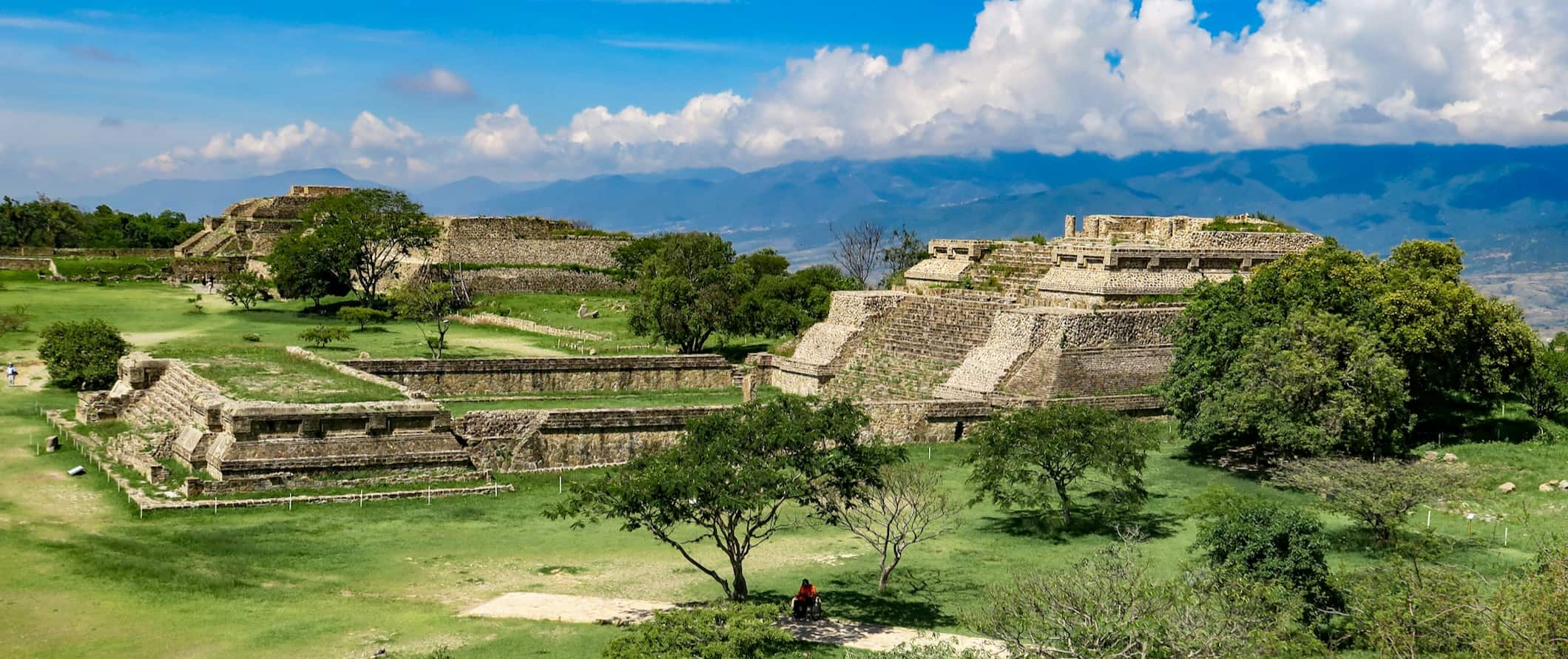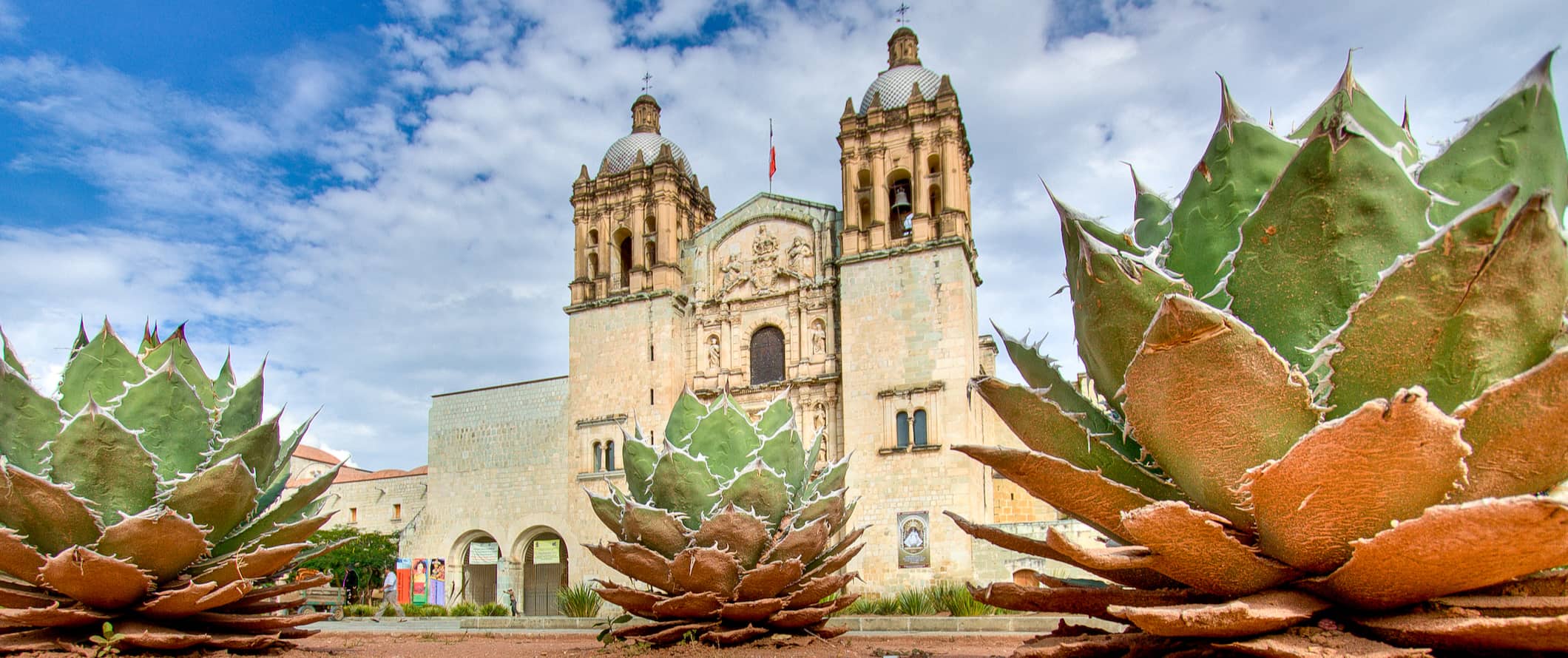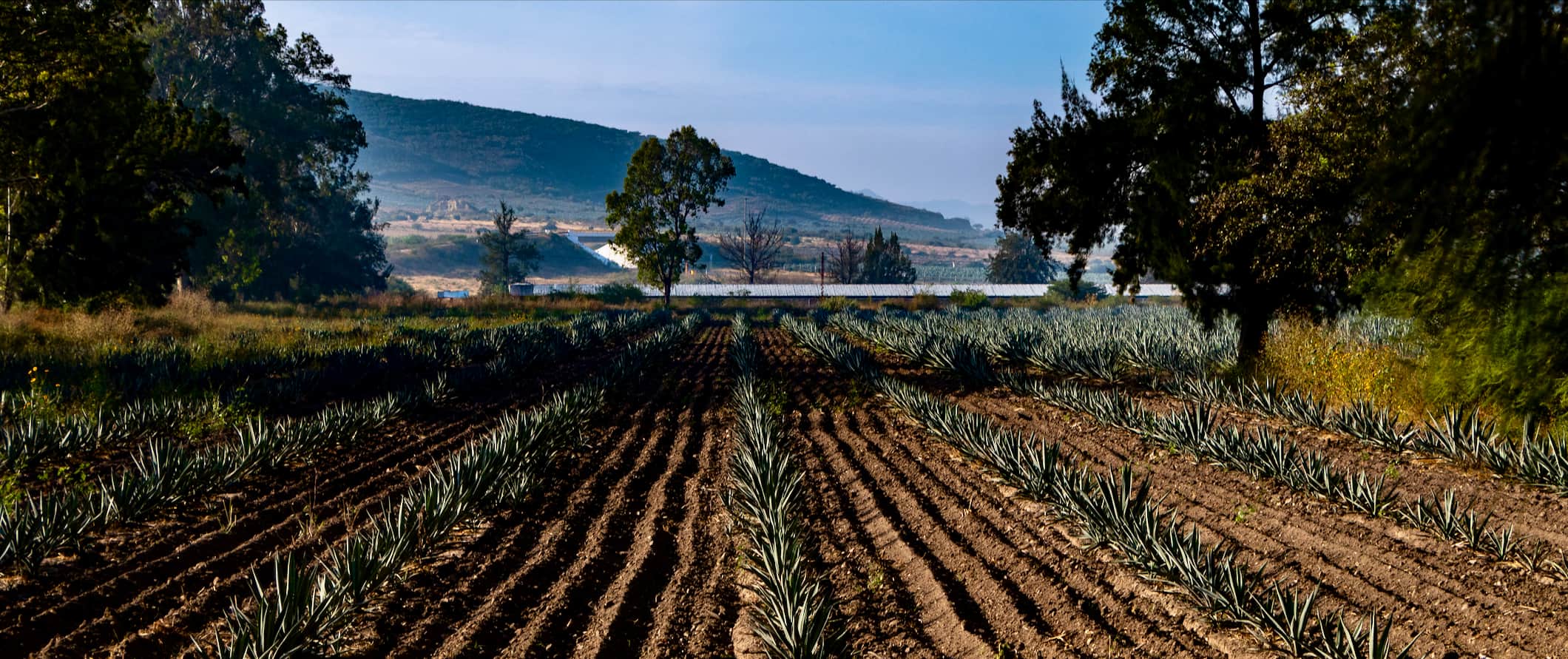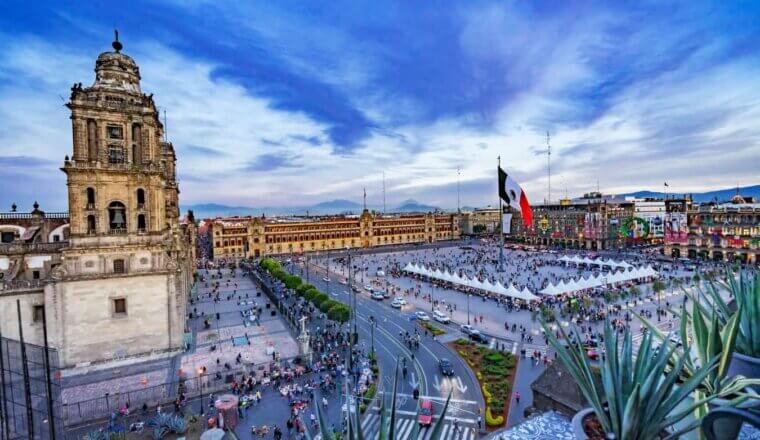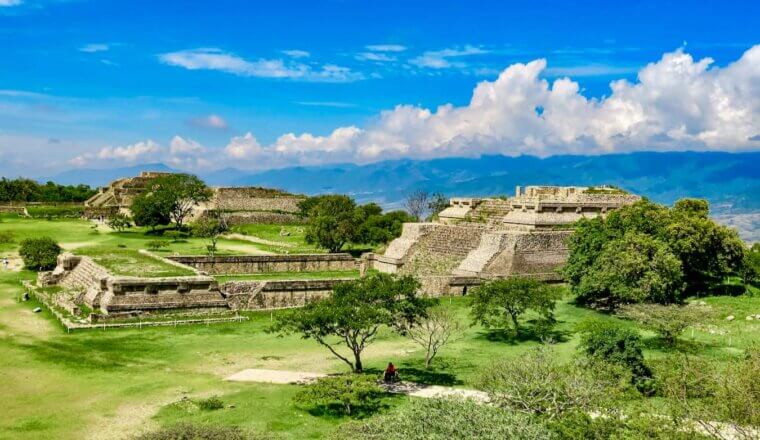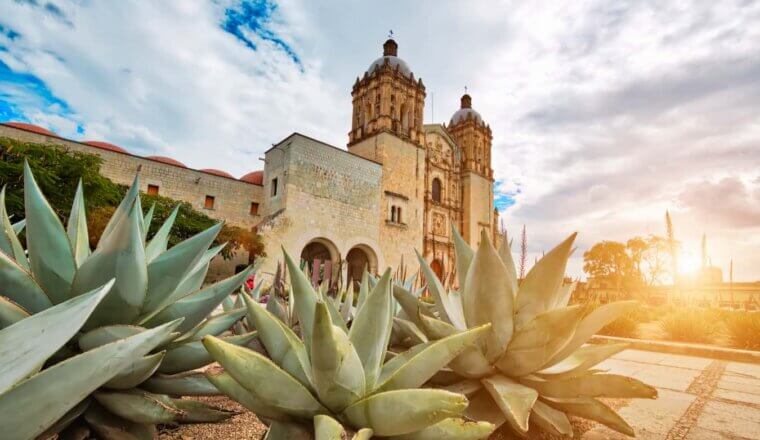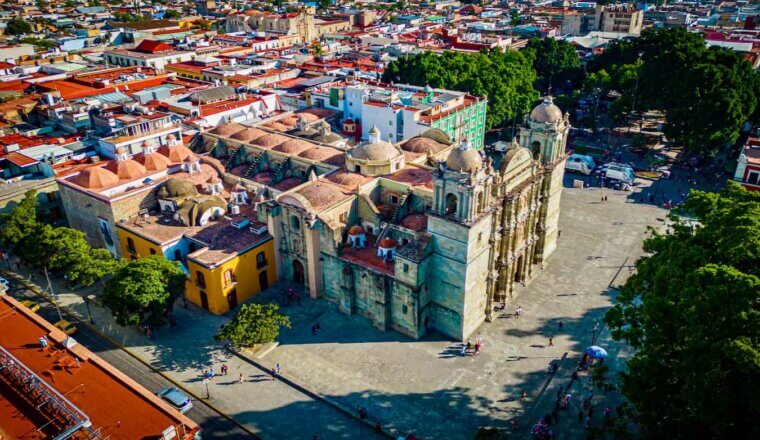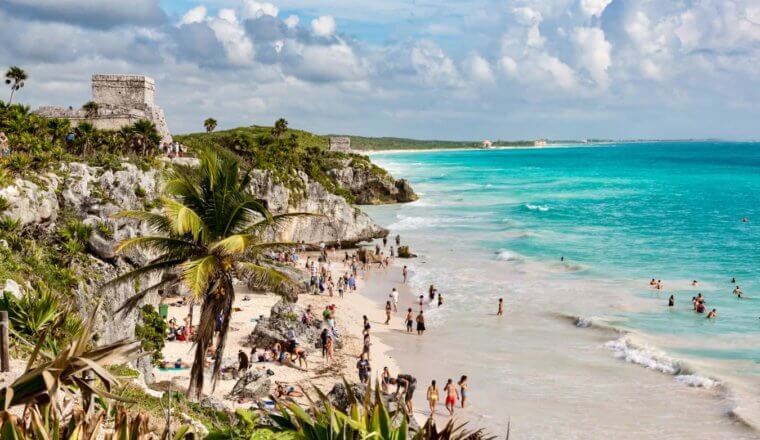From the moment I arrived, I knew Oaxaca was a special place. The city’s energy and mine just synched. We were a pair. My eyes constantly shifted to every shade of color, every movement, as if I had an insatiable hunger to take in everything.
That love has only grown deeper with each subsequent visit (and there have been many).
Oaxaca is a city of colorful buildings, scenic rooftop restaurants and bars, street art, historic Spanish colonial churches, cobblestone streets, and picturesque parks. It’s also one of the gastronomic centers of Mexico and a hub for making mezcal in the country.
Located in a valley surrounded by craggy mountains in southwestern Mexico, Oaxaca and its surrounds have been inhabited for thousands of years by indigenous Zapotec and Mixtec peoples. Today, Oaxaca is a center for heritage tourism, owing to the many historical attractions (including Monte Albán, a UNESCO Heritage Site; and Mitla, a Zapotec archeological site) in the city and surrounding area.
With mouth-watering food, the best mezcal in the world, and tons of history, it’s no surprise I fell in love with Oaxaca. I’ve never met anyone who didn’t love it. All the hype you hear about it is true.
This travel guide to Oaxaca will help you see all the sites, save money, and fall in love with it too.
Table of Contents
Top 5 Things to See and Do in Oaxaca
1. Wander the historic downtown
The entire downtown of Oaxaca was designated a UNESCO World Heritage Site in 1987. There are over 1,200 historic buildings here, most of which are hundreds of years old. Historical downtown Oaxaca is the perfect place to explore iconic landmarks like the Zocalo courtyard (the courtyard in front of the National Palace), the Cathedral of Our Lady of the Assumption, and the Santa Domingo Cultural Center. Spend some time wandering to take in their vibrant colors and historic architecture, and stop in for a Mezcal cocktail at any of the lively downtown bars.
2. Explore Mercado 20 de Noviembre
This covered market is home to all kinds of delicious street food as well as fresh, local produce. Construction on the market began in 1862 but wasn’t finalized until 1882, and was later named after the start date of the Mexican Revolution in 1910. It has remained one of Oaxaca’s culinary and cultural hubs for over a hundred years. Be sure to try some of the amazing grilled meats as they are a local favorite! Definitely eat here at least once. It’s open daily from 7am-9pm.
3. See Monte Albán
This pre-Columbian archeological site is located just 15 minutes outside the city. Founded in the 6th century BCE, it’s a UNESCO World Heritage Site full of ancient Zapotec pyramids, terraces, and canals that span several miles. Admission is 70 MXN while full-day tours (that include other stops) are 724 MXN.
4. Explore Mitla
This pre-Columbian UNESCO site was built in 850 CE and was mostly destroyed by the Spanish when they arrived in the mid-16th century. However, some buildings were left intact, which you can get up close and explore (some of which date as far back as 400 CE). Mitla was one of the main religious and spiritual hubs for the indigenous Zapotec and Mixtec people, and was used as a sacred burial site. Admission is 75 MXN while skip-the-line tickets are 160 MXN.
5. Try a street-stall hamberguesa
The hamberguesa is a delicious but unhealthy must-eat meal. It’s a burger topped with a hot dog, sliced cheese, Oaxaca cheese, ham, pineapple, lettuce, tomato, and jalapeño. It’s all the unhealthy foods you could ever want for just 50 MXN. Cangreburguer sells one of the best.
Other Things to See and Do in Oaxaca
1. Learn about mezcal
I love mezcal (which is one of the reasons why I love Oaxaca). This is the birthplace of mezcal, a spirit distilled from agave. Unlike tequila, which is also made from agave, when making mezcal, the heart of the plant is cooked in a pit in the ground before it is crushed. Then water is added, and it’s allowed to ferment. Since the plant is cooked, mezcal has a much smokier flavor than tequila.
If you want to learn more about this popular (and delicious) spirit, Rambling Spirits runs the best mezcal tours in Oaxaca. Go with them if you want to learn more. Their guides have incredible knowledge and can take you to places the bigger tours can’t. I learned a ton on this tour and highly recommend it! Most tours leave after lunch so it’s a perfect way to spend the remainder of your day.
2. Take a free walking tour
One of the first things I do when I visit a new city is take a free walking tour. They’re the best way to see the main sights, get introduced to the city and culture, and connect with a local guide who can answer all your questions. Oaxaca Free Walking Tour offers free daily tours that show you the hidden gems of the city and what life is like for the locals who live here. Just make sure to tip your guide at the end!
3. See the Templo de Santo Domingo
This Baroque Roman Catholic church was started in 1572, though it wasn’t completed until 1731. It was originally used as a Dominican church and monastery. During Mexico’s revolutionary war (1910-1920), the church was annexed and used as a barracks and military building. It was transformed into a museum in the 1970s and is now home to all kinds of religious and pre-Columbian artifacts. The interior is incredibly ornate, with intricate carvings on the walls. Admission is free. Be sure to dress respectfully.
4. Wander the Botanical Garden
These gardens span over two acres and are located near the Church of Santo Domingo. The gardens feature different plants from across the state (Oaxaca is one of the most biologically diverse regions in the country). In addition to the flowers, trees, and cacti that dot the garden, there are also sculptures and works of art too. Self-guided tours are not allowed so you’ll need to go with a guide. One-hour tours are offered Monday through Saturday. There is only one English tour available per day, however. Admission (including the tour) is 50 MXN for Spanish tours and 100 MXN for tours in English.
5. Visit Puerto Escondido
Located on the Pacific Coast 6 hours away by car, Puerto Escondido is famous for its stunning beaches and rambunctious nightlife. If you’re looking for a quick weekend getaway from Oaxaca, head here to lounge away the days and party all night. Playa Manzanillo and Puerto Angelito are the best beaches for swimming and lounging while Playa Zicatela is great for surfing. Avoid staying in the middle of Zicatela as it’s boring. If you’re backpacking, stay at the very south where all the hostels are. It’s a lively area.
6. Take a food tour
If you’re a foodie like me, one of the best ways to get a sense of the local food scene is to take a guided food tour. I highly recommend doing one here since Oaxaca is such a center for gastronomy. Oaxaca has some of the most diverse selections of dishes in Mexico. Oaxaca Eats runs several tours, most of which last around 4 hours. You’ll get to sample 20+ dishes. Tour prices vary but expect to spend 2,000 MXN.
7. Wander the Sunday market
Mercado Tlacolula is one of the most popular markets in the region. It’s essentially been in operation for centuries and is a good place to buy local crafts, produce, food, and everything in between. It’s located 45-minutes outside the city so you’ll need to drive there or take the bus, but it’s absolutely worth the journey. There are thousands of people here and tons of amazing food to try. Don’t miss barbacoa (stewed meat) and chicharrón (fried pork rinds).
8. Try a cooking class
If you want to learn how to make some of the amazing dishes you’ve eaten here, take a cooking class. Most classes take you to the market so you can buy fresh ingredients before you start cooking. Classes last around 5 hours and are hands-on and fully immersive. Usually, you’ll make one appetizer, some salsa, a main mole dish (mole is a specific sauce and one of the region’s specialties), and a dessert. Expect to spend around 1,900 MXN for a class.
9. Go hiking in Sierra Norte
Sierra Norte offers visitors over 100 kilometers (62 miles) of hiking trails spanning over 40 different trails. Located just two hours by car from Oaxaca, you’ll also see a handful of Zapotec villages (Pueblos Mancomunados) along the way that offer village-to-village treks and homestays. At Sierra Nore, keep in mind that trails are not well-marked so you’ll need to hire a guide (going solo is possible but not recommended). Guides are incredibly knowledgeable and can point out wildlife (there are pumas, bobcats, armadillos, and more here), identify plants, and ensure you don’t get lost (plus, hiring a guide helps support the local economy). Multi-day tours (which trek from village to village) cost around 3,600 MXN per person for a 3-day tour.
10. Experience a Temazcal
Temazcal (meaning “house of heat”) is a traditional Zapotec sweat lodge. You’ll sit in a small domed hut that becomes increasingly warmer. You’ll rub everything from clay to fresh fruit juices and peels on your skin as you heat up, cooling down by dunking yourself in cold water. It’s a very meditative, spiritual experience with numerous health benefits. Visits usually last an hour and cost around 600 MXN.
11. Celebrate Day of the Dead
The Day of the Dead (Día de Los Muertos) is one of the biggest celebrations/festivals in all of Mexico. It occurs between October 31st and November 2nd and is a time meant for remembering loved ones who have passed. Locals paint their faces, visit cemeteries, and give offerings. There are all kinds of celebrations and parades too. Oaxaca hosts one of the biggest festivals in all of Mexico. It’s one of the best (and busiest) times to visit Oaxaca. Be sure to book your accommodation early as hotels and hostels sell out months in advance. If you want a local guide during the Day of the Dead, expect to pay around 1,250 MXN.
If you’re visiting other cities in Mexico, check out these guides:
Oaxaca Travel Costs
Hostel prices – A bed in dorm costs between 250-450 MXN per night regardless of how big the dorm is. Free Wi-Fi is standard and many hostels also include free breakfast. Most have self-catering facilities too. Private rooms cost 600-1,500 MXN per night.
For those traveling with a tent, a basic plot for two people without electricity can be found outside the city for around 200 MXN per night. The campgrounds are 20 minutes outside the city by car.
Budget hotels – Budget two-star hotels with ensuite bathrooms start at 700 MXN per night. These include basic amenities like TV, AC, and free Wi-Fi.
Airbnb is also available here, with private rooms starting at 200 MXN per night (though they average closer to 950 MXN). Entire homes/apartments cost at least 400 MXN (but average double or even triple that price). Be sure to book early for the best deals.
Food – Oaxaca is a gastronomical hub in Mexico and is known for unique dishes such as tlayudas (a tortilla filled with beans, lettuce, cheese, and your protein of choice, grilled to be crispy on the outside), memelas, and mole (a sauce with lots of ingredients, sometimes including chocolate, and served with rice and tortillas).
Street stalls and markets are your best choice for authentic and inexpensive food. Tacos, quesadillas, sopas, tortas, and other street foods are generally 15-45 MXN. Sometimes, you’ll find tacos for as cheap as 10 MXN. In Oaxaca, street food is the best — and most affordable — option.
Be sure to hit the markets here too. At the Mercado Sanchez Pascua, there is a tamale lady in the back who has some of the most delicious tamales in Oaxaca (try the salsa verde!). She is so popular that she’s often sold out by 10am. In the most famous market, Mercado 20 de Noviembre, there is a section full of BBQ stalls where you can order a plate full of meat and some veggies on the side, cooked right in front of you. Don’t miss out.
Surprisingly, there are not as many taco stands around the city center but if you make your way up to the ADO bus station and look across the street, there is a long line of taco stalls set up. Most of them have the exact same fare — tacos al pastor, for 10 MXN each. At the far end, you will see one with pots full of bubbling stews of meat — tacos casuales — and they go for 15 MXN each.
A meal at a local Mexican restaurant serving traditional cuisine costs around 80-200 MXN. Look for the ones filled with locals as that is generally a sign that the food is really good. For comparison, a combo meal at McDonald’s costs around 110 MXN.
A national beer is around 30 MXN while a latte/cappuccino is 45 MXN. Bottled water is 10 MXN. A glass of mezcal will cost between 80-240 MXN depending on what kind you get.
Tap water is not safe to drink in Mexico. Bring a portable water purifier (LifeStraw makes a good one) to save money and reduce your reliance on single-use plastic bottles.
If you plan to cook your meals, expect to pay between 500-575 MXN per week for basic staples like rice, beans, veggies, and some meat.
Some of my favorite restaurants are Boulenc, Los Danzantes, La Mezcaloteca, Tlayudas El Negro, Cactus Loncheria, Lechoncito de Oro, Santo Sabor Restaurante, Tastavins, Casa Taviche, Casa Oaxaca el Restaurante, and Praga Coffee Bar.
Backpacking Oaxaca Suggested Budgets
If you’re backpacking Oaxaca, expect to spend 800 MXN per day. This budget gets you a hostel dorm, street food and self-cooked meals, public transportation, and a few cheap attractions, such as a visit to Monte Albán and a free walking tour. If you plan on eating out more or drinking lots of mezcal, add another 60-150 MXN per day.
On a mid-range budget of 1,750 MXN per day, you can stay in a private Airbnb, eat at restaurants serving cheap traditional cuisine for every meal, enjoy a few drinks, take the occasional taxi to get around, and do more paid activities like cooking classes or museum visits.
On a “luxury” budget of 3,400 MXN or more per day, you can stay in a hotel, eat out for all your meals anywhere you want, have plenty of drinks, take taxis everywhere or rent a car, and do some guided food or mezcal tours. This is just the ground floor for luxury though. The sky is the limit!
Oaxaca Travel Guide: Money-Saving Tips
Like the rest of Mexico, Oaxaca is super affordable. However, with so many tempting eateries and mezcalerias, it’s easy to go overboard and spend too much (that’s what happened to me and my entire group of friends). Lucky, there’s plenty of ways to cut your costs. Here are some tips to help you save money in Oaxaca:
- Shop at the markets for food – Oaxaca’s markets are a great place to eat inexpensively and stock up on food for day trips. Binge on fresh fruit, tacos, and grilled meat — it’s all super cheap!
- Eat street food – Street food is the best food in the city — and the cheapest. Stick to street stalls to save money and enjoy the country’s best eats. Most meals won’t be more than 30 MXN.
- Take a free walking tour – A free walking tour is the best way to see the main sights and connect with a local guide. Oaxaca Free Walking Tour offers daily tours that give you a solid intro to the city. Just be sure to tip your guide at the end!
- Stay with a local – Use Couchsurfing to connect with locals and find free accommodation. If you send your request in advance, you can likely find a host who can share their insider tips and knowledge with you.
- Drink less – Alcohol is cheap in Mexico, but it’s definitely more expensive at bars and clubs. Try to buy your alcohol from a local store instead of drinking at the bar if you’re on a budget.
- Skip the taxis – Oaxaca is easy to explore on foot and the bus goes pretty much everywhere you need it. Skip the taxis!
- Being a water filter – Since the tap water here isn’t safe to drink and single-use plastic is bad for the environment, bring a water filter. LifeStraw makes reusable bottles with a built-in filter so you can ensure your water is always clean and safe.
Where to Stay in Oaxaca
Oaxaca has plenty of affordable hostels. Here are some suggested places to stay if you’re on a budget:
For more suggestions, check out my complete list of the best hostels in Oaxaca.
How to Get Around Oaxaca
On foot – Oaxaca is super pedestrian-friendly. Unless you’re heading out to the nearby ruins, you can just walk everywhere in the downtown area.
Bus – Collectivos (shared taxis that drive set routes) are available around the city and usually cost around 15 MXN.
Taxi – Taxis start at 55 MXN and go up by region traveled. For example, anywhere in the historic center costs 55 MXN, even if you only travel 1 block or 10. If you want to go to the neighboring region of La Reforma from the historic center, it costs 70 MXN, and so on. A taxi to the airport should be about 150-200 MXN, depending on which region you’re staying in (and what time of day/night it is, with nighttime being a bit higher). While affordable, they add up quickly so skip the taxis if you can.
Though Uber is not in Oaxaca, you can use a similar app called Didi. International credit cards don’t seem to work with the app, so make sure you have close to the right amount of change as the suggested fare cost (taxi drivers don’t usually have a lot of change). Rides with this app exclusively use taxis.
Bicycle – Bike rentals can be found for around 100 MXN for a half-day rental. For a guided mountain bike trip, expect to spend around 1,300 MXN for a half-day excursion.
Car rental – Car rentals cost around 650 MXN per day. Unless you’re going to do some day trips (or multi-day trips) outside the city (such as a trip to Puerto Escondido) then you likely don’t need a car. Renters must be 21 years of age and have had their license for at least two years.
Some companies require renters to be over 25. Deposits on car rentals can also be quite steep, with some companies asking for $1,000 USD as a deposit
When to Go to Oaxaca
Oaxaca’s elevation offers a relatively pleasant climate year-round. The most popular time to visit is December-January when many Canadian and American tourists flock south to avoid the winter. This is when the city is busiest and prices are highest. Daily highs are comfortable and not too hot, hovering around 25°C (77°F).
Expect crowds around the Day of the Dead (late October/early November). If you’re visiting then, be sure to book your accommodation well in advance.
The summer sees more rain, though the weather is still warm and sunny. Expect daily averages around 26°C (79°F).
How to Stay Safe in Oaxaca
Oaxaca is generally one of the safest cities in Mexico. You don’t find the kind of drug or tourist-related violence and thefts you find elsewhere. That being said, it is still always best to practice personal safety and never stop being aware of your surroundings.
Be sure to take a taxi home after a night out just to be safe. Also, don’t carry all your valuables with you everywhere you go (unless it’s to or from the airport). Leave your passport at your accommodation and only take enough money with you for what you feel you need to do.
When possible, it’s always best to walk with a friend or a small group. Avoid wearing flashy jewelry and waving around lots of money or high-end electronics (both during the day and at night). There’s been a rise in late-night petty theft since COVID so it’s better to be safe than sorry, especially if you are coming around major festivals.
Solo female travelers should generally feel safe here, even walking alone. However, the standard precautions always apply (never leave your drink unattended at the bar, never walk home alone intoxicated, etc.). For specific tips, check out one of the many solo female travel blogs about the city.
If you rent a vehicle, never leave any valuables in it overnight.
If an emergency occurs, dial 911. If that doesn’t work (since 911 isn’t available everywhere), dial 066.
Overall, dangerous crimes against tourists are very uncommon here. The people who do tend to be involved in incidents are usually doing drugs or taking part in sex tourism. Avoid all of that and you’ll greatly reduce your risks here. I never feel unsafe here and neither do my friends that live here, even the women.
Always trust your gut instinct. Avoid isolated areas at night, and be aware of your surroundings at all times. Make copies of your personal documents, including your passport and ID.
The most important piece of advice I can offer is to purchase good travel insurance. Travel insurance will protect you against illness, injury, theft, and cancellations. It’s comprehensive protection in case anything goes wrong. I never go on a trip without it as I’ve had to use it many times in the past.
Oaxaca Travel Guide: The Best Booking Resources
These are my favorite companies to use when I travel. They consistently have the best deals, offer world-class customer service and great value, and overall, are better than their competitors. They are the companies I use the most and are always the starting point in my search for travel deals.
- Skyscanner – Skyscanner is my favorite flight search engine. They search small websites and budget airlines that larger search sites tend to miss. They are hands down the number one place to start.
- Hostelworld – This is the best hostel accommodation site out there with the largest inventory, best search interface, and widest availability.
- Booking.com – The best all around booking site that constantly provides the cheapest and lowest rates. They have the widest selection of budget accommodation. In all my tests, they’ve always had the cheapest rates out of all the booking websites.
- Get Your Guide – Get Your Guide is a huge online marketplace for tours and excursions. They have tons of tour options available in cities all around the world, including everything from cooking classes, walking tours, street art lessons, and more!
- SafetyWing – Safety Wing offers convenient and affordable plans tailored to digital nomads and long-term travelers. They have cheap monthly plans, great customer service, and an easy-to-use claims process that makes it perfect for those on the road.
- LifeStraw – My go-to company for reusable water bottles with built-in filters so you can ensure your drinking water is always clean and safe.
- Unbound Merino – They make lightweight, durable, easy-to-clean travel clothing.
- Top Travel Credit Cards – Points are the best way to cut down travel expenses. Here’s my favorite point earning credit cards so you can get free travel!
Oaxaca Travel Guide: Related Articles
Want more info? Check out all the articles I’ve written on backpacking/traveling Mexico and continue planning your trip:

